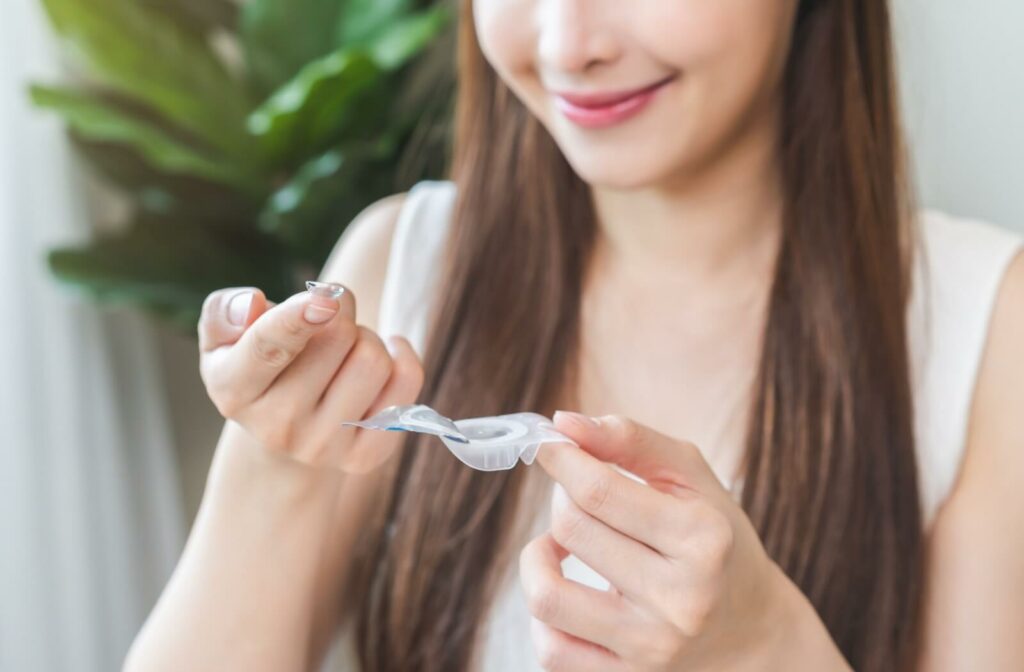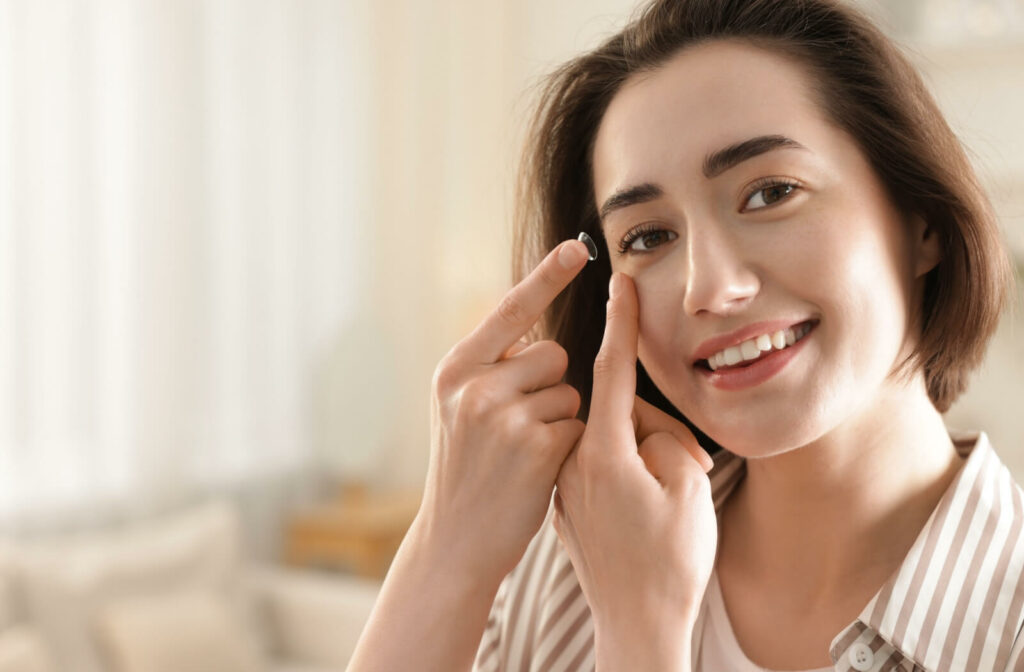If you wear contact lenses, you may be familiar with the scratchy, irritated feeling that dry eyes can cause. However, discomfort doesn’t need to be a normal part of your day.
The type of contact lens you wear can make a significant difference to your well-being. The most suitable contacts for dry eyes often feature modern materials and technologies designed to retain moisture and improve breathability. These lenses work with your eye’s natural tear film to provide hydration throughout the day. Getting a proper contact lens exam with an eye care professional is the first step to finding a comfortable solution.
How Contacts & Dry Eyes Affect Each Other
When you wear contacts, you might notice that your eyes feel dry or uncomfortable from time to time. This happens for reasons related to how your lenses interact with your eyes. Understanding how to wear contacts with dry eyes can help you find a more comfortable lens.
Common Issues for Lens Wearers
A contact lens is a medical device that sits directly on the surface of your eye. However, contacts can sometimes interfere with the normal function of your tear film. Some common concerns include:
- Less oxygen reaches the cornea
- Certain lens materials lose moisture quickly
- A lens that does not fit quite right
- Protein buildup on reusable lenses
What to Look for in Contacts for Dry Eyes
When you look for new contacts, certain features can make a big difference in comfort. Focus on options that help your eyes stay hydrated and feel good all day. Modern lens technology offers several solutions for dryness.
Moisture Retention & Technology
Some contact lenses have technology built in to hold moisture. These designs create a cushion of hydration on the surface of the lens, which helps keep your eyes from feeling dry, even after hours of wear.
High Oxygen Permeability
Lenses that let more oxygen pass through to your eye can help reduce irritation. For instance, some contact lenses are made from silicone hydrogel, a material known for its high oxygen permeability, which lets your eyes “breathe” more freely.
Lens Material & Water Content
You might think that lenses with high water content are better, but that’s not always the case for dry eyes. Lenses with lower water content need less moisture from your tear film to stay hydrated. This can be a good choice if your eyes are naturally dry.
Contact Lens Types To Consider
There are several types of contact lenses available that work well for people with dry eye symptoms. Each type offers different benefits, so it is helpful to know your options. The right type for you depends on your specific eye health and lifestyle.
Daily Disposable Lenses
With daily disposables, you get a fresh, clean pair of lenses every single day. This reduces the chance of protein deposits building up on the lens surface.

Soft Lenses with Silicone Hydrogels
These lenses combine a soft, flexible material with silicone hydrogel, which allows much more oxygen to reach your eyes compared to older hydrogel lenses. The increased oxygen flow promotes better eye health and comfort.
Scleral Lenses
Scleral lenses are larger and rest on the white part of your eye—the sclera. They vault over your cornea, leaving space for a fluid reservoir that constantly bathes your cornea in moisture. This design can help prevent dry eye.
Lens Options for Dryness & Astigmatism
Many brands offer lenses designed for comfort and hydration. If you also have astigmatism, you need lenses that offer both clear vision and a stable, comfortable fit. Fortunately, there are many options that address both needs.
Daily & Monthly Options
Your doctor can discuss specific brands with features designed to address dryness. Some examples include:
- Alcon DAILIES TOTAL1: These lenses feature a water gradient technology that provides a cushion of moisture on the lens surface.
- ACUVUE OASYS 1-DAY: This option uses technology to help keep your tear film stable and comfortable.
- Bausch + Lomb Ultra: This monthly lens is designed to maintain a high percentage of its moisture for up to 16 hours.
Toric Lenses for Astigmatism
Toric lenses are specially designed for astigmatism. Their shape is different from a standard spherical lens to correct the specific curvature of your eye. This design provides clear and stable vision by preventing the lens from rotating.
Options for Astigmatism & Dryness
Toric lenses can also incorporate moisture-retaining technologies. Two examples are:
- Biofinity Toric: A monthly lens known for its stable design that reduces lens movement and promotes comfort.
- Acuvue Oasys 1-Day for Astigmatism: A daily disposable that provides high oxygen permeability and a stable fit.
Tips to Improve Comfort with Contact Lenses
Besides changing your lenses, a few simple habits can help your eyes feel more comfortable throughout the day. Small adjustments to your routine can have a noticeable impact. These practices can support your eye health and extend your comfortable wear time.
Limit Your Wear Time
Give your eyes a rest. Try to wear your glasses for a few hours in the evening. You could also dedicate one day a week to go contact-free to let your eyes recover.
Use The Right Rewetting Drops
Not all eye drops are safe for contacts. Look for drops specifically labeled “for use with contact lenses” to lubricate your eyes. Using the correct drops can help alleviate the symptoms of dry eye and prevent damage to your lenses.
Re-evaluate Your Lens Solution
The preservatives in some contact lens solutions can cause irritation for sensitive eyes. A switch to a preservative-free or a hydrogen peroxide-based solution might make a difference. Always follow the instructions for any new cleaning system.
Finding the right contact lens starts with a conversation about your specific needs. At Vision One Boise, we use a comprehensive approach to identify the cause of your discomfort and match you with a lens that supports your eye health. Schedule a visit with an optometrist in Boise to explore your options and find lasting comfort.



